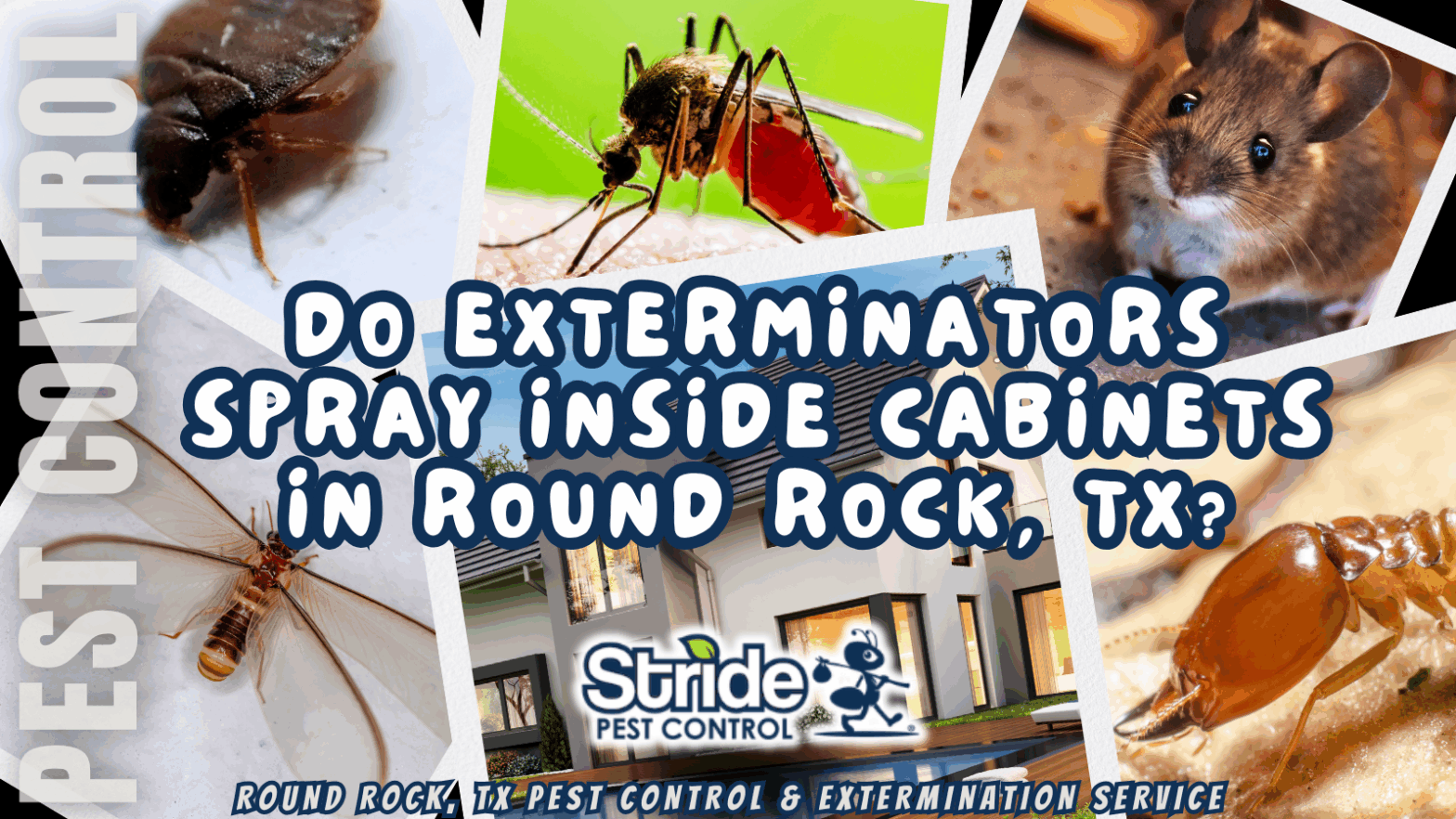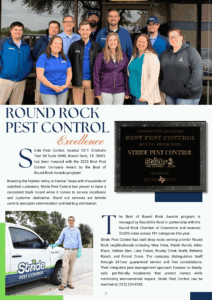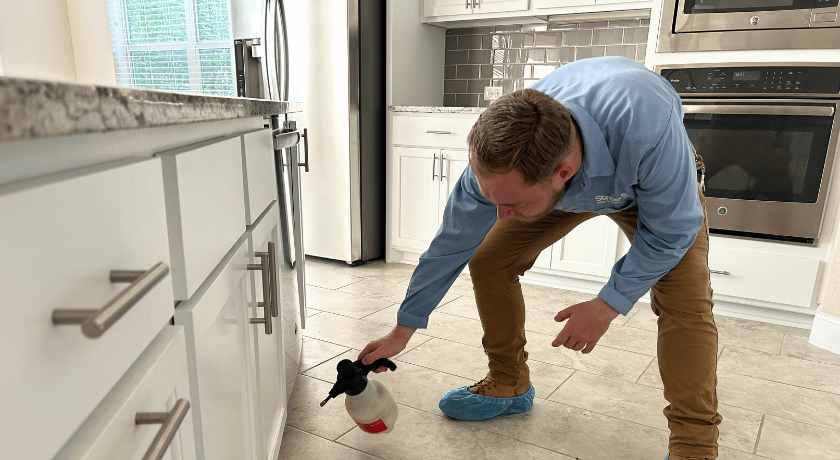
Exterminators in Round Rock, TX, typically spray inside cabinets to address pest infestations effectively. They assess the situation and use different treatments based on the pest type. Treatments may include sprays, baits, and dusts, targeting pests lurking in cabinets. Homeowners can expect thorough inspections and advice on prevention to avoid future issues. Proper preparation of cabinets is important for successful extermination. For detailed insights on what to expect during treatment and post-care steps, explore Round Rock extermination company.
Key Article Highlights
- Exterminators in Round Rock, TX, typically spray inside cabinets to eliminate pests like ants and cockroaches hiding in dark areas.
- Treatments may include spray insecticides, bait stations, and dust treatments specifically applied within cabinets for effective pest control.
- A thorough inspection of cabinets is conducted to identify signs of infestations before any treatment is applied.
- Exterminators also provide recommendations for pest prevention strategies to keep cabinets pest-free after treatment.
- Regular cabinet maintenance and inspections are important to prevent future infestations and ensure long-term effectiveness of treatments.
Understanding the Extermination Process
Extermination begins with a careful assessment of the problem. Exterminators observe the area to identify the type of pest and its behavior. Understanding pest behavior is essential for effective extermination. Different pests require different extermination techniques. Once the assessment is complete, a plan is made. This plan may include traps, sprays, or baits. The chosen technique depends on the pest and its location. Exterminators also consider safety for humans and pets. They explain the process to the homeowner, ensuring clarity. After treatment, follow-up visits may be necessary to monitor the situation. This thorough approach helps in achieving successful extermination and prevents future infestations. Mastery of the extermination process relies on knowledge of pests and effective techniques. Integrated pest management, which includes chemical treatments, is often utilized to ensure the most effective results. Additionally, exterminators may use perimeter sprays to create a protective barrier around the home. To enhance effectiveness, they may also employ residual sprays that target pests in hard-to-reach areas, including inside cabinets.
Common Pests Found in Cabinets
Cabinets can often become a hiding place for various pests. Common pests found in cabinets include ants, cockroaches, and pantry moths. These insects seek food and shelter in dark, undisturbed areas. Effective pest identification techniques are essential for recognizing signs of infestations. Homeowners should look for droppings, shed skins, or damaged food items. Regular cabinet maintenance tips can help prevent pest problems. Keeping cabinets clean and organized discourages pests from settling in. Sealing cracks and ensuring proper food storage can further reduce risks. Additionally, using airtight containers for food helps keep pests at bay. By staying vigilant and proactive, homeowners can protect their cabinets from unwanted visitors.
Why Cabinets Are Important in Pest Control

Effective pest control relies heavily on the condition and maintenance of cabinets. Cabinets serve as common hiding spots for pests, such as cockroaches and ants. When cabinets are well-maintained, they can help prevent infestations. Cracks, gaps, and moisture can attract pests, making cabinet maintenance essential. Regular cleaning and inspection can deter unwanted visitors. It is important to guarantee that food items are stored properly and that spills are cleaned immediately. Sealing any openings can also aid in pest prevention. Homeowners should be proactive in checking cabinets for signs of pests. By prioritizing cabinet maintenance, individuals can create a less inviting environment for pests, making pest control efforts more effective. Proper care of cabinets is a key step in safeguarding homes from infestations. Additionally, implementing measures such as mattress encasement can enhance overall pest prevention strategies. Furthermore, addressing entry points in cabinets can significantly reduce the chances of rodent access and activity.
What to Expect During an Extermination Visit
During an extermination visit, homeowners can expect a thorough inspection of their property. The exterminator will look for signs of pests in various areas, including cabinets and under sinks. They will use an extermination checklist to guarantee no detail is missed. After the inspection, the exterminator will explain the findings and suggest treatments for pest control. Homeowners should ask questions about pest prevention strategies during this time. The exterminator may recommend sealing entry points and keeping areas clean. This visit is not just about extermination; it focuses on long-term solutions to prevent future infestations. Overall, the goal is to guarantee a pest-free home through effective treatment and prevention measures.
Types of Treatments Used Inside Cabinets

After the inspection, the exterminator may recommend specific treatments for areas like cabinets. These cabinet treatments are important for effective pest prevention. Different methods can be used based on the type of pests found. Below is a table outlining common treatments:
| Treatment Type | Description | Purpose |
|---|---|---|
| Spray Insecticides | Liquid applied inside cabinets | Kill existing pests |
| Bait Stations | Stations placed in cabinets | Attract pests |
| Dust Treatments | Powder applied in cracks | Long-lasting effect |
| Gel Treatments | Gel placed in targeted areas | Specific pest control |
| Essential Oils | Natural repellents | Prevent pest entry |
These treatments guarantee cabinets remain pest-free and contribute to a healthier home environment.
Safety Precautions for Homeowners
How can homeowners guarantee safety while dealing with pest treatments? First, they should choose a licensed exterminator. This guarantees that the pest prevention methods used are safe and effective. Homeowners must inform the exterminator about any pets or children in the home. Proper safety measures include removing food items and covering surfaces to avoid contamination. Additionally, it is wise to vacate the premises during the treatment. After spraying, homeowners should wait the recommended time before returning. Ventilating the area is vital to disperse any lingering chemicals. Finally, reading and following all safety instructions provided by the exterminator will help maintain a safe environment. By taking these steps, homeowners can minimize risks while effectively managing pest issues.
Preparing Your Cabinets for Extermination
Before extermination begins, homeowners must prepare their cabinets to guarantee effective pest control. Proper cabinet organization is essential for pest prevention. This preparation helps exterminators access all areas needing treatment.
| Step | Action |
|---|---|
| Clear Cabinets | Remove all items from inside cabinets |
| Clean Surfaces | Wipe down shelves and corners |
| Check for Damage | Inspect for signs of pests or damage |
Signs of Pest Infestation in Cabinets
Signs of pest infestation in cabinets can be easy to spot. Homeowners may notice visible bug droppings, chewed food packaging, or unusual odors. Recognizing these signs early can help prevent a larger problem.
Visible Bug Droppings
Visible bug droppings often indicate a pest problem lurking in cabinets. These droppings can vary in size and color, depending on the type of pest. Pest identification becomes essential when analyzing these droppings. Homeowners should examine the droppings closely to determine their source. For example, small, dark pellets may suggest a rodent issue, while fine, powdery residue often points to insects like cockroaches or ants. Conducting a droppings analysis helps in understanding the severity of the infestation. Finding droppings in cabinets is a clear sign that action is needed. It is important to address this issue promptly to prevent further damage and health risks. Identifying pests early can lead to effective control measures.
Chewed Food Packaging
Chewed food packaging frequently serves as a clear indicator of a pest problem in cabinets. When packaging shows signs of being nibbled or torn, it suggests that pests are nearby. Common pests, such as mice or insects, are often attracted to the contents inside these packages. The presence of chewed packaging can lead to further infestation if not addressed quickly. It is important for homeowners to check cabinets regularly for any signs of damage. If chewed packaging is found, it is a strong signal to take action. Ignoring this sign can result in more pests entering the home. Taking steps to eliminate pest attraction, such as proper storage, can help prevent future issues.
Unusual Odors Present
Unusual odors can indicate the presence of pests in cabinets. These smells often come from droppings, decaying food, or pest bodies. Identifying these unusual odors is essential for effective pest identification. When homeowners notice strange scents, it may signal the need for further investigation. Common pests, such as rodents and insects, can leave behind distinct odors. For example, a musty smell might suggest mold or moisture issues linked to pests. A strong, foul odor could indicate a dead rodent. Recognizing these signs early can help prevent a larger infestation. Homeowners should not ignore unusual odors, as they can lead to serious problems. Professional exterminators can assist in determining the source and resolving pest issues effectively.
Follow-Up Care After Treatment
Follow-up care after treatment is essential for maintaining a pest-free environment. After extermination, homeowners should focus on post treatment maintenance. This includes regularly inspecting areas where pests may enter, such as cracks and gaps. Keeping food stored properly and cleaning up spills can help reduce the risk of re-infestation. Ongoing pest prevention is also important. Homeowners should consider using preventative measures like sealing entry points and removing standing water. Regularly scheduled inspections by professionals can catch any new pest activity early. Maintaining a clean and organized space further supports pest control efforts. Additionally, targeting areas such as pet bedding and shaded yard areas can enhance long-term pest management. By following these steps, homeowners can guarantee their environment remains pest-free long after the initial treatment. Consistency is key in achieving long-term success.
Choosing the Right Exterminator in Round Rock
Choosing the right exterminator in Round Rock is important for effective pest control. One should consider the experience and expertise of the exterminator. Additionally, it is essential to look at the service options available to meet specific needs.
Experience and Expertise
When seeking an exterminator in Round Rock, experience and expertise play essential roles in ensuring effective pest control. An experienced exterminator understands pest biology, which helps identify different pest types and their behaviors. This knowledge allows them to select the best treatment techniques to eliminate pests safely and efficiently.
Moreover, expertise in the field means that the exterminator is familiar with local pest issues and seasonal trends, which can impact treatment plans. A skilled professional will also know how to implement preventative measures to keep pests from returning. By choosing an exterminator with a strong background, homeowners can feel confident that they are making the right choice for their pest control needs.
Service Options Available
A variety of service options are available to homeowners seeking extermination in Round Rock. Many exterminators offer pest prevention plans, which help keep homes free from unwanted insects and rodents. These plans may include regular inspections and treatments to guarantee long-term protection.
Additionally, some services focus on cabinet cleaning, addressing pests that may hide in kitchen storage areas. This thorough cleaning can help prevent infestations and maintain a healthy environment.
Homeowners should evaluate their specific needs when choosing an exterminator. It is crucial to select a service that provides targeted solutions, including pest prevention and cabinet cleaning, to guarantee effective extermination and minimize future issues.
Frequently Asked Questions
How Long Does Extermination Inside Cabinets Typically Take?
Extermination duration inside cabinets usually takes about 30 minutes to an hour. Proper cabinet preparation is essential for effectiveness. This guarantees that all areas are treated, maximizing the chances of eliminating pests inside.
Are Extermination Products Safe for Food Stored in Cabinets?
Extermination safety is essential when dealing with food. Exterminators guarantee food protection by using products that are safe for stored items. Proper precautions are taken to minimize any risk during the extermination process in cabinets.
Will I Need to Vacate My Home During Treatment?
Like a butterfly emerging from a cocoon, a home may need time to breathe post-treatment. Exterminator advice often suggests vacating for safety. Ensuring home safety during extermination helps protect residents from potential chemical exposure.
Can I Clean My Cabinets Before Extermination?
Before extermination, cleaning cabinets is beneficial. It helps remove food particles and clutter. Organizing cabinets also improves efficiency. Cleaning tips include removing items, wiping surfaces, and ensuring everything is stored properly for easy access post-treatment.
What Happens if Pests Return After Extermination?
If pests return after extermination, it often requires reevaluation. Pest prevention strategies may need adjustment, and follow-up inspections can help identify new infestations, ensuring effective solutions are implemented to maintain a pest-free environment.
Call today if you are in need of a pest exterminator in Round Rock, TX!
(512) 254-8185
DO EXTERMINATORS SPRAY INSIDE CABINETS IN ROUND ROCK, TX PDF

